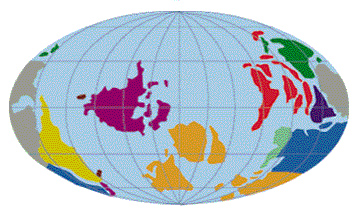This picture is an example of early autotrophs.
Click on image for full size
Image courtesy of Corel Photography
Early Life
Organisms that are able to make their own food (in the form of sugars) by
using the energy of the
Sun are called autotrophs, meaning "self-feeders".
Photosynthesis is the name of the process through which these autotrophs covert solar energy to biological energy.
Because the autotrophic bacteria were no longer dependent on the same
limited food supply as their heterotrophic
ancestors, they were able to flourish. Photosynthesis was mostly along sulphur or methane pathways, however, and not the familiar carbon dioxide pathway most plants use today. Moreover, these photosynthetic pathways are not oxygenic (O2 is not produced). The following is an example:

As a result of the activity of these bacteria, S began to build up in the world's atmosphere and oceans. The production of atmospheric O2 became possible only later after the oxidation state of the oceans changed.
You might also be interested in:

Photosynthesis is the name of the process by which autotrophs (self-feeders) convert water, carbon dioxide, and solar energy into sugars and oxygen. It is a complex chemical process by which plants and
...more
The first beings were probably much like coacervates. As a group, these bacteria are called heterotrophic anaerobes. Because there was virtually no oxygen in the atmosphere at this time, these bacteria
...more
Though not the largest kingdom, with a mere 300,000 species catalogued, many might argue that the Kingdom Plantae just may be the most important group of living organisms. In the process known as "photosynthesis",
...more
The Archean is the name of the age which began with the forming Earth. The duration of the Archean, 2.8 billion years, is more than half the expected age of the Earth. We don't know much about this period,
...more
Eventually, as with the development of photosynthesis along sulfur and methane pathways, where sulfur and methane products are produced, photosynthesis along the oxygen pathway, where oxygen is produced,
...more
Extreme environments are places that are inhospitable to most "normal" living creatures. Extreme environments are not necessarily lifeless. Certain types of organisms, known collectively as "extremophiles",
...more
Some environments are inhospitable to most "normal" living creatures. However, these extreme environments are not necessarily lifeless. Certain types of organisms, known collectively as "extremophiles",
...more
















